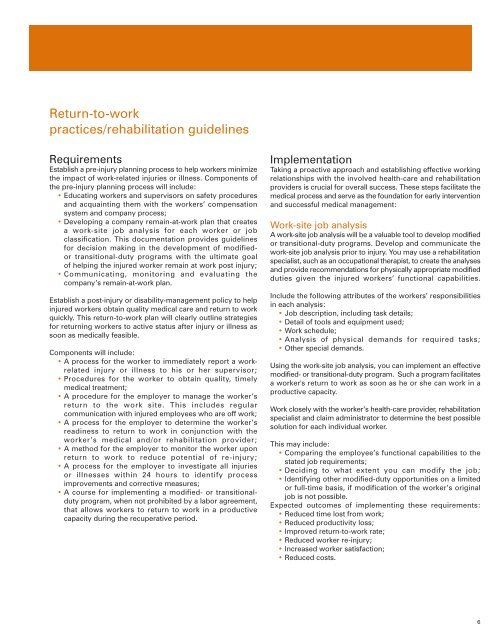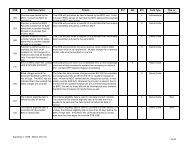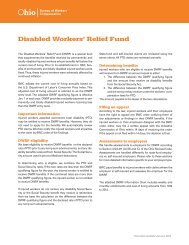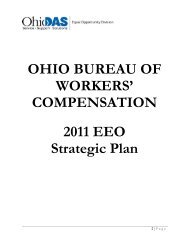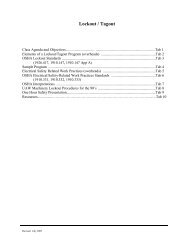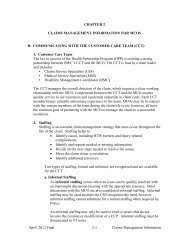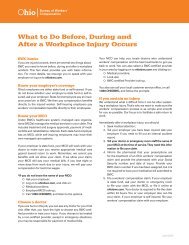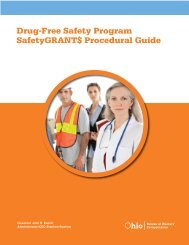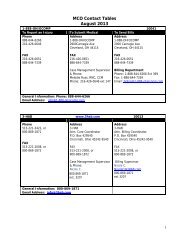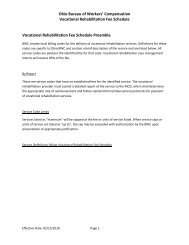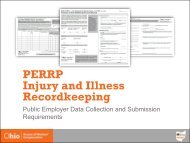BWC 10-Step Business Plan for Safety - Ohio Bureau of Workers ...
BWC 10-Step Business Plan for Safety - Ohio Bureau of Workers ...
BWC 10-Step Business Plan for Safety - Ohio Bureau of Workers ...
You also want an ePaper? Increase the reach of your titles
YUMPU automatically turns print PDFs into web optimized ePapers that Google loves.
Return-to-work<br />
practices/rehabilitation guidelines<br />
Requirements<br />
Establish a pre-injury planning process to help workers minimize<br />
the impact <strong>of</strong> work-related injuries or illness. Components <strong>of</strong><br />
the pre-injury planning process will include:<br />
• Educating workers and supervisors on safety procedures<br />
and acquainting them with the workers’ compensation<br />
system and company process;<br />
• Developing a company remain-at-work plan that creates<br />
a work-site job analysis <strong>for</strong> each worker or job<br />
classification. This documentation provides guidelines<br />
<strong>for</strong> decision making in the development <strong>of</strong> modifiedor<br />
transitional-duty programs with the ultimate goal<br />
<strong>of</strong> helping the injured worker remain at work post injury;<br />
• Communicating, monitoring and evaluating the<br />
company’s remain-at-work plan.<br />
Establish a post-injury or disability-management policy to help<br />
injured workers obtain quality medical care and return to work<br />
quickly. This return-to-work plan will clearly outline strategies<br />
<strong>for</strong> returning workers to active status after injury or illness as<br />
soon as medically feasible.<br />
Components will include:<br />
• A process <strong>for</strong> the worker to immediately report a workrelated<br />
injury or illness to his or her supervisor;<br />
• Procedures <strong>for</strong> the worker to obtain quality, timely<br />
medical treatment;<br />
• A procedure <strong>for</strong> the employer to manage the worker’s<br />
return to the work site. This includes regular<br />
communication with injured employees who are <strong>of</strong>f work;<br />
• A process <strong>for</strong> the employer to determine the worker’s<br />
readiness to return to work in conjunction with the<br />
worker’s medical and/or rehabilitation provider;<br />
• A method <strong>for</strong> the employer to monitor the worker upon<br />
return to work to reduce potential <strong>of</strong> re-injury;<br />
• A process <strong>for</strong> the employer to investigate all injuries<br />
or illnesses within 24 hours to identify process<br />
improvements and corrective measures;<br />
• A course <strong>for</strong> implementing a modified- or transitionalduty<br />
program, when not prohibited by a labor agreement,<br />
that allows workers to return to work in a productive<br />
capacity during the recuperative period.<br />
Implementation<br />
Taking a proactive approach and establishing effective working<br />
relationships with the involved health-care and rehabilitation<br />
providers is crucial <strong>for</strong> overall success. These steps facilitate the<br />
medical process and serve as the foundation <strong>for</strong> early intervention<br />
and successful medical management:<br />
Work-site job analysis<br />
A work-site job analysis will be a valuable tool to develop modified<br />
or transitional-duty programs. Develop and communicate the<br />
work-site job analysis prior to injury. You may use a rehabilitation<br />
specialist, such as an occupational therapist, to create the analyses<br />
and provide recommendations <strong>for</strong> physically appropriate modified<br />
duties given the injured workers’ functional capabilities.<br />
Include the following attributes <strong>of</strong> the workers’ responsibilities<br />
in each analysis:<br />
• Job description, including task details;<br />
• Detail <strong>of</strong> tools and equipment used;<br />
• Work schedule;<br />
• Analysis <strong>of</strong> physical demands <strong>for</strong> required tasks;<br />
• Other special demands.<br />
Using the work-site job analysis, you can implement an effective<br />
modified- or transitional-duty program. Such a program facilitates<br />
a worker's return to work as soon as he or she can work in a<br />
productive capacity.<br />
Work closely with the worker’s health-care provider, rehabilitation<br />
specialist and claim administrator to determine the best possible<br />
solution <strong>for</strong> each individual worker.<br />
This may include:<br />
• Comparing the employee’s functional capabilities to the<br />
stated job requirements;<br />
• Deciding to what extent you can modify the job;<br />
• Identifying other modified-duty opportunities on a limited<br />
or full-time basis, if modification <strong>of</strong> the worker’s original<br />
job is not possible.<br />
Expected outcomes <strong>of</strong> implementing these requirements:<br />
• Reduced time lost from work;<br />
• Reduced productivity loss;<br />
• Improved return-to-work rate;<br />
• Reduced worker re-injury;<br />
• Increased worker satisfaction;<br />
• Reduced costs.<br />
6


